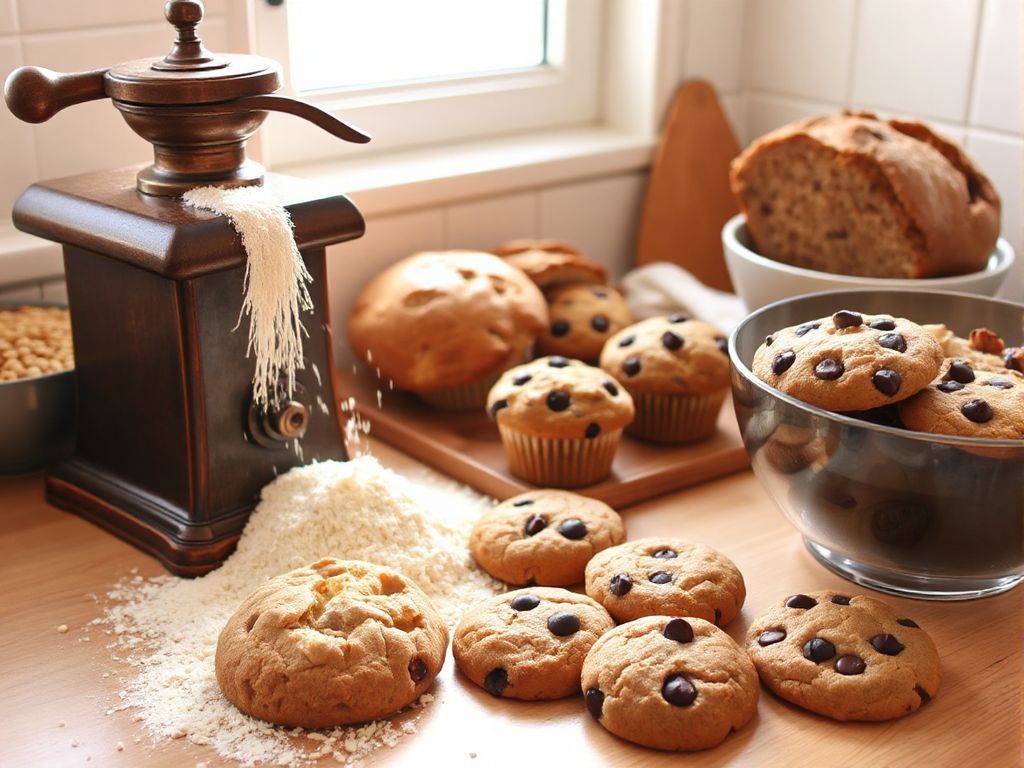If you’re a baking enthusiast or simply enjoy the art of creating something delicious from scratch, you’ve probably wondered if freshly milled flour makes a significant difference. The short answer is: absolutely. Freshly milled flour can transform your baked goods in terms of flavor, nutritional value, and texture. But why does this happen, and is it worth the extra effort? Let’s dive in.
What Is Freshly Milled Flour?
Freshly milled flour is made by grinding whole grains immediately before use, retaining all parts of the grain:
- Bran: The fiber-rich outer layer.
- Endosperm: The starchy middle layer.
- Germ: The nutrient-packed core.
In contrast, commercial flours are often stripped of the bran and germ during processing to extend shelf life, which can diminish flavor and nutritional quality.
Why Freshly Milled Flour Matters
1. Enhanced Flavor
When grains are freshly ground, they retain their natural oils and volatile compounds, which provide richer and more complex flavors. Over time, these oils oxidize, leading to a bland taste in older flour. Freshly milled flour brings a nutty, slightly sweet, and earthy flavor that can elevate your bread, cakes, and pastries.
Example: Imagine baking bread with freshly milled wheat flour. The flavor is fuller, with subtle undertones you won’t find in store-bought flour. It’s like the difference between freshly brewed coffee and instant coffee.
2. Higher Nutritional Value
Freshly milled flour retains all the nutrients of the whole grain, including:
- B vitamins
- Vitamin E
- Minerals like magnesium, zinc, and iron
- Dietary fiber
In commercially processed flour, these nutrients are often lost during refinement or over time.
Pro Tip: If you’re pursuing a healthier lifestyle, baking with freshly milled flour ensures your baked goods are not just tasty but also nutritious.
3. Improved Texture
Fresh flour produces a better texture in your baked goods due to its higher moisture and oil content. For instance:
- Bread rises higher and has a more robust crumb.
- Pastries are flakier.
- Cakes turn out moister and softer.
Does Freshly Milled Flour Change Baking?
Yes, it can. While it offers amazing benefits, baking with freshly milled flour comes with some considerations:
- Moisture Content: Freshly milled flour has more moisture, which may require adjustments to your recipes.
- Learning Curve: Its higher nutrient content and active enzymes might affect the dough’s hydration and fermentation.
- Storage: It doesn’t last as long as processed flour and should be used within days for optimal freshness.
Tip: If you’re new to milling your own flour, start small by mixing freshly milled flour with store-bought flour until you get a feel for the changes.
Is Milling Your Own Flour Worth It?
Pros:
- Total control over the type of grains you use.
- Fresher, healthier, and more flavorful baked goods.
- Freedom to experiment with unique grains like spelt, einkorn, or rye.
Cons:
- Requires a grain mill, which is an investment.
- Adds time to your baking process.
- Limited shelf life means you must plan your baking around your milling.
Where to Start
If you’re ready to explore the world of freshly milled flour, here’s how to begin:
- Choose a Grain Mill: Popular options include electric mills like the NutriMill or manual mills for smaller batches.
- Pick Your Grains: Wheat, rye, and spelt are excellent for beginners. You can also experiment with ancient grains like emmer or kamut for unique flavors.
- Milling Process: Grind only as much flour as you need to avoid waste.
For more on how to mill flour at home, this guide is a great resource.
FAQs About Freshly Milled Flour
- How long does freshly milled flour last?
- It’s best used within 3–7 days to retain maximum flavor and nutrients.
- Can I mix freshly milled flour with store-bought flour?
- Yes, combining them can ease the transition into baking with fresh flour.
- Do I need special recipes for freshly milled flour?
- Not necessarily, but you may need to adjust water or liquid ratios.
- What grains work best for beginners?
- Start with hard or soft wheat, as they’re versatile for bread and pastries.
- Does freshly milled flour taste different?
- Yes! It has a noticeably richer and fresher flavor profile.
- Do I need a grain mill?
- While you can use a blender in a pinch, a grain mill is more efficient.
- Can I store milled flour in the freezer?
- Absolutely! Freezing extends its freshness and prevents spoilage.
- Is freshly milled flour gluten-free?
- Only if you mill gluten-free grains like rice or buckwheat.
- What’s the cost of milling flour at home?
- It varies but is generally economical in the long run, especially if you bake often.
- What’s the best grain for bread?
- Hard red wheat or hard white wheat are ideal for bread due to their higher gluten content.


